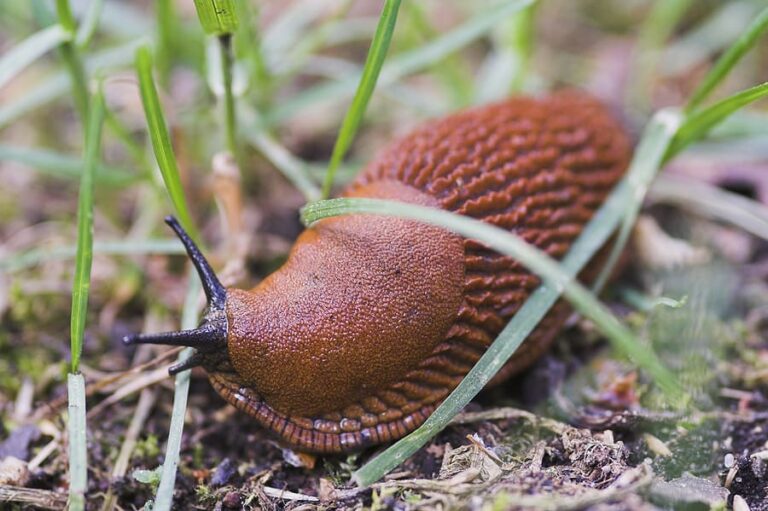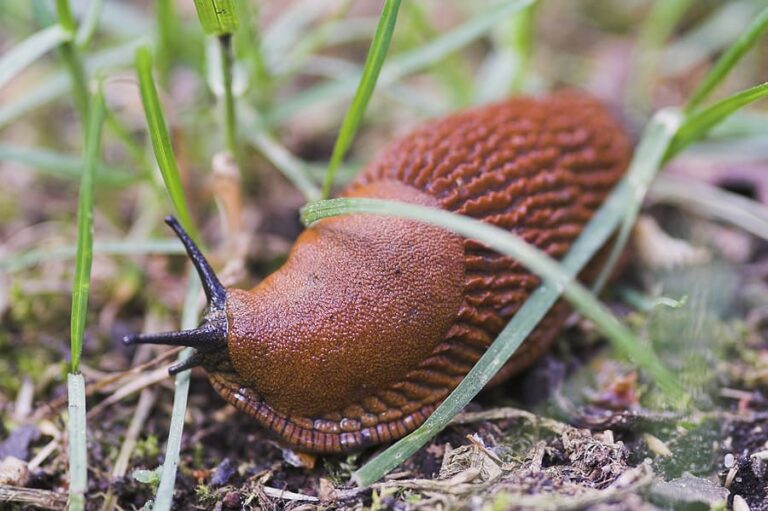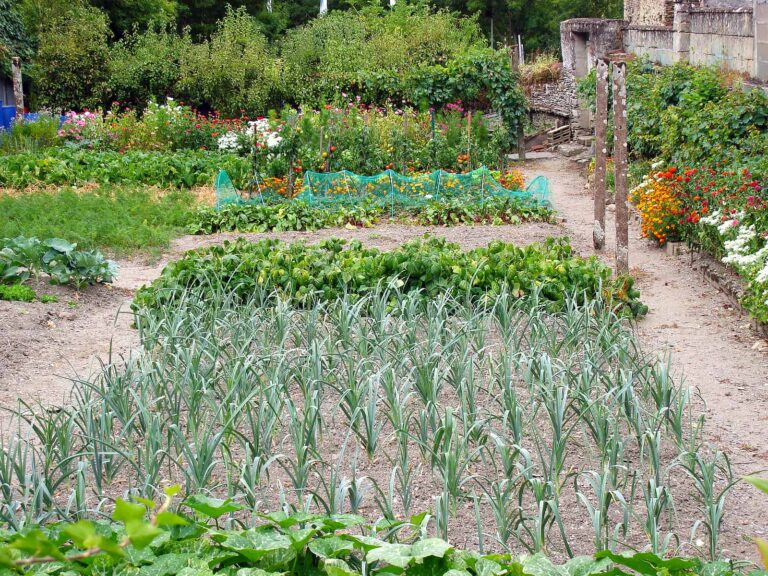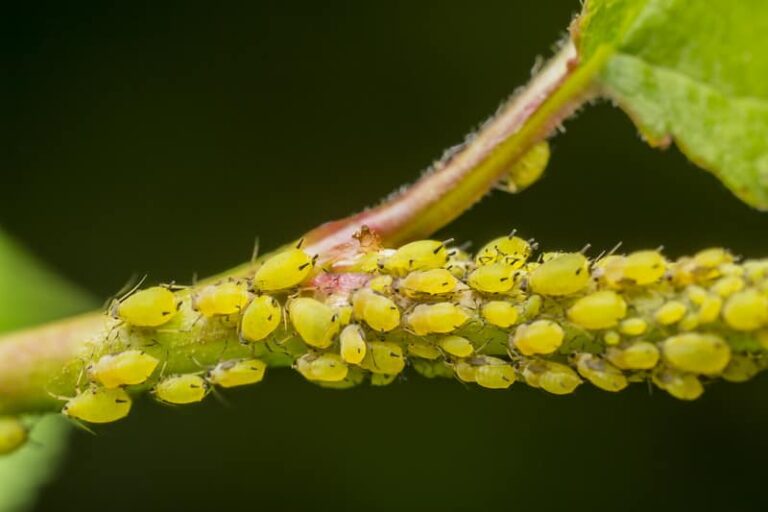Cucumber Beetle Organic Pest Control
The cucumber beetle is an oblong greenish-yellow beetle with black spots or stripes on its wing covers. The cucumber beetle is about ¼ inch long.
Cucumber beetles feed mainly on members of the cucurbit family—cucumbers, melons, and squashes—and also asparagus, early beans, corn, eggplant, peas, potatoes, and tomatoes. They attack seedlings feeding on young shoots and leaves. They also attack older plants eating holes in leaves and fruit.
Cucumber beetles carry the bacillus Erwinia tracheiphila which causes bacterial wilt in plants. And, cucumber beetles can spread mosaic virus by feeding on an infected plant then feeding on a healthy plant. There is no cure for mosaic virus or bacterial wilt.
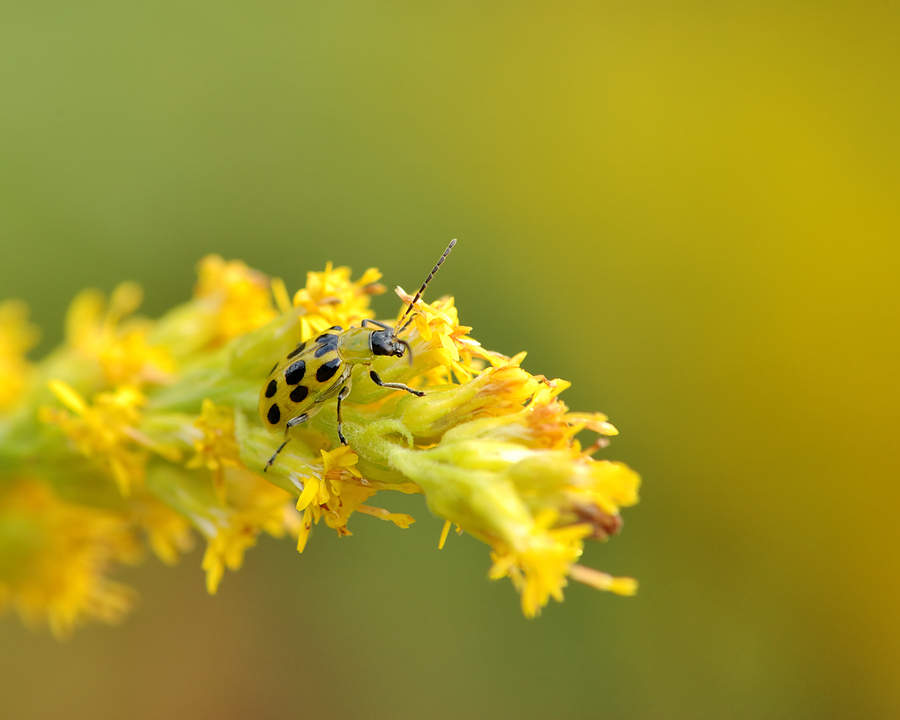
Overwintering adult beetles emerge from garden debris or weeds in the spring and lay eggs in the soil close to plants. The eggs hatch and larvae feed in the roots and crowns of plants for 2 to 4 weeks then pupate. The larva of the cucumber beetle is called the southern corn rootworm.
There are two to three generations of cucumber beetles each year.
Scientific name: Diabrotica undecimpunctata howardi (spotted cucumber beetle); Acalymma vittatum (striped cucumber beetle).
Cucumber beetle and corn rootworm lifecycle
Cucumber beetles—spotted and striped—eat a variety of crops, not just cucumbers.
Cucumbers, corn, lima and snap beans, melons, peas, pumpkins, potatoes, sweet potatoes, peanuts, eggplant, tomatoes, summer and winter squash—cucumber beetles feed on more than 280 plants. They feed on leaves and flowers and tunnel into fruit; early in the season, they eat young seedlings.
The larval stage of the cucumber beetle is called the corn rootworm which feeds on the roots of corn.
Cucumber beetles are yellow, the size of ladybugs, but pointier in front. The cucumber beetle is of the genus Diabrotica; there are 338 species worldwide, seven in North America.
The spotted cucumber beetle is the most widespread. It is ¼ inch long, greenish-yellow with a small black head and twelve black spots on its back. The striped cucumber beetle is the same size pale yellow to orange with a black head and three black stripes down its back.
Cucumber beetles lay yellow-orange eggs in the soil at the base of plants. In mid-summer white larvae about ½ inch long (with a brown head and brown spot on the last segment of the body) feed on roots and soon weaken host plants. Adults chew leaves and flowers; an adult cucumber beetle will eat the tassels, leaves, and silks of corn plants. Feeding adults can transmit bacterial wilt and cucumber mosaic virus to vegetable crops.
There are two to four generations of cucumber beetles each year; adults overwinter in garden debris and emerge in spring when temperatures reach 65°F.
Target plants
Larvae feed on roots of corn, beans, and other legumes and many vegetables especially cucurbits (cucumbers, melons, and squash). Adults feed on beans, corn, peas, cucumbers, melons, squashes, and the flower petals of many plants.
Feeding habits and damage
Feeding cucumber beetles leave large, ragged, roughly oval holes in leaves and flowers. As they feed, the beetles can spread bacterial wilt and mosaic virus. Larvae feed on the roots of corn often killing young plants; older plants are weakened and may die.
Cucumber beetles control
Here are cucumber beetle natural organic controls.
Organic controls overview
A barrier of agricultural fleece will keep beetles from flying in to lay eggs near the plants. Cucumber peelings or squash cut in half and coated with rotenone can be used as traps for beetles. Diatomaceous earth can be spread around the base of plants as a barrier to egg laying; leaves can be dusted at night to control adults. Parasitic nematodes can be applied to soil weekly to control larvae. Large infestations of adults can be controlled with pyrethrum or rotenone sprays.
Keep the garden clean
Remove plant debris from the garden each year; cucumber beetles overwinter in plant materials left in the garden. Cultivate the garden in fall and early spring; this will expose overwintering beetles to killing frost and freezing weather.
Timed planting and trap crops
Plant crops late; cucumber beetles emerge in spring when temperatures average 65°F; if host crops aren’t in the garden, cucumber beetles will go elsewhere to feed. An alternative is to plant a trap crop of host plants that will attract beetles and their larvae; these crops can be sprayed to kill off beetle infestations and new crops for harvest can then be planted.
Row covers
Keep seedlings covered with row covers—horticultural cloth or cheesecloth–to exclude beetles from flying in and laying eggs. Once plants begin to flower remove row covers to allow pollinating insects to reach flowers.
Sticky traps
Cucumber beetles are attracted to the color yellow. Place yellow sticky traps around the garden to catch adult beetles. You can paint a sheet of cardboard yellow and cover it with an adhesive such as Tanglefoot to make your own traps, or you can purchase sticky traps at a garden center.
Cucumber traps
Cucumber peelings and the rinds of cantaloupes contain cucurbitacin, a chemical that attracts cucumber beetles. Place peelings or rinds around the garden and coat them with insecticidal rotenone dust or spray. Check the traps daily. Squash blossoms also attract beetles. Check blossoms for beetles in the late evening to handpick and crush beetles.
Handpicking
Picking beetles off of crops by hand daily will greatly reduce adult beetle damage. Hold open a plastic bag and give plant foliage a gentle shake (beetles take shelter in the shade of foliage); beetles will tumble off plants and into the bag. Place the bag in a freezer until the beetles are dead or set the bag in the sun and let them cook.
Nematodes
Heterorhabditis nematodes attack cucumber beetle larvae. Nematodes are available commercially and can be added to the soil at planting time. Nematodes (microscopic worm-like creatures) burrow below the root zone in time so multiple applications of nematodes may be necessary.
Toads and other natural predators
Toads will eat cucumber beetles (and earwigs and cutworms among other pests)—give toads water and dark, damp spots to shelter in your garden. Insect predators include beneficial nematodes, soldier beetles, and braconid, chalcid, and Trichogramma wasps (wasps parasitize the eggs). Animal predators include Baltimore orioles, bluebirds, brown thrashers, chickadees, juncos, phoebes, purple finches, sparrows, towhees, and warblers.
Deterrent plants
Nasturtiums deter cucumber beetles and bean beetles. Plant nasturtiums on the border or among the crops you want to protect.
Pyrethrins
Use a pyrethrum-based pesticide for serious infestation—as a last resort. Pyrethrum comes from a plant, Chrysanthemum cinerariaefolium. There are several pyrethrum-based pesticides. Those containing pyrethrum are made using parts of the plant itself and are the least toxic. Those labeled pyrethrin are made from the toxic chemicals extracted from the plant. Pyrethrum-based pesticides are lethal to both pest insects and beneficial insects. Target only areas where the beetle infestation is most severe. Use these pesticides in the evening when cucumber beetles have settled on plants and beneficial insects are least active; pyrethrum dissipates quickly, and most of the toxicity will be gone by morning.
Pyrethroids are synthetic compounds similar to pyrethrin but much stronger and often combined with other toxins. They also can be used as a last resort against cucumber beetles.
Organic control calendar
Here is what you can do seasonally to control cucumber beetles:
- Before planting: Remove crop residue from the garden. Plant an extra early squash-family crop as a trap crop then destroy the beetles attracted to it.
- At planting time: Plant crops late to avoid the first generation of beetle feeding and egg laying. Cover seedlings or transplants with floating row covers and hand-pollinate covered squash crops or remove the cover when plants flower. Pile deep straw mulch around plants to discourage the movement of beetles between plants. Place yellow sticky traps in the garden.
- While crops develop: Spray kaolin clay on the undersides of leaves to deter beetles. Handpick beetles as often as possible; crush them or drop them in soapy water. Use a handheld vacuum to collect beetles, then dump them in soapy water. Grow vine crops on trellises which makes spotting beetles easier. Drench the soil with Heterorhabditis nematodes to kill larvae. Spray pyrethrin to kill beetles.
- After harvest: Remove all crop debris from the garden after harvest to destroy overwintering spots for beetles. Turn the soil just before frost to expose dormant beetles to killing cold.
Related Posts:
Ultimate Beginner to Expert Guide to Growing Cucumbers
Planning and Planting
- The Best Cucumber Varieties for Your Garden
- How to Plant Cucumber Seeds and Seedlings: Site, Spacing and Soil Needs
- Growing Cucumbers in Containers: Space -Saving Tips for Success
Care and Maintenance
- Watering, Feeding, and Caring for Cucumbers: A Complete Guide
- How and When to Prune Cucumbers for Healthier Vines
- How to Grow Cucumbers That Are Not Bitter Tasting
- Cucumber Flowering, Pollination, and Fruit Formation: Ensuring Maximum Yield
Troubleshooting and Pest Control
Harvest and Beyond
- Nine Cucumber Serving and Cooking Tips
- When and How to Harvest Cucumbers
- How to Store and Preserve Cucumbers for Freshness and Flavor
Related articles:
Vegetable Garden Organic Pest Control
Vegetable Garden Diseases Problem Solver
Vegetable Garden Organic Weed Control
Garden Planning Books at Amazon:


